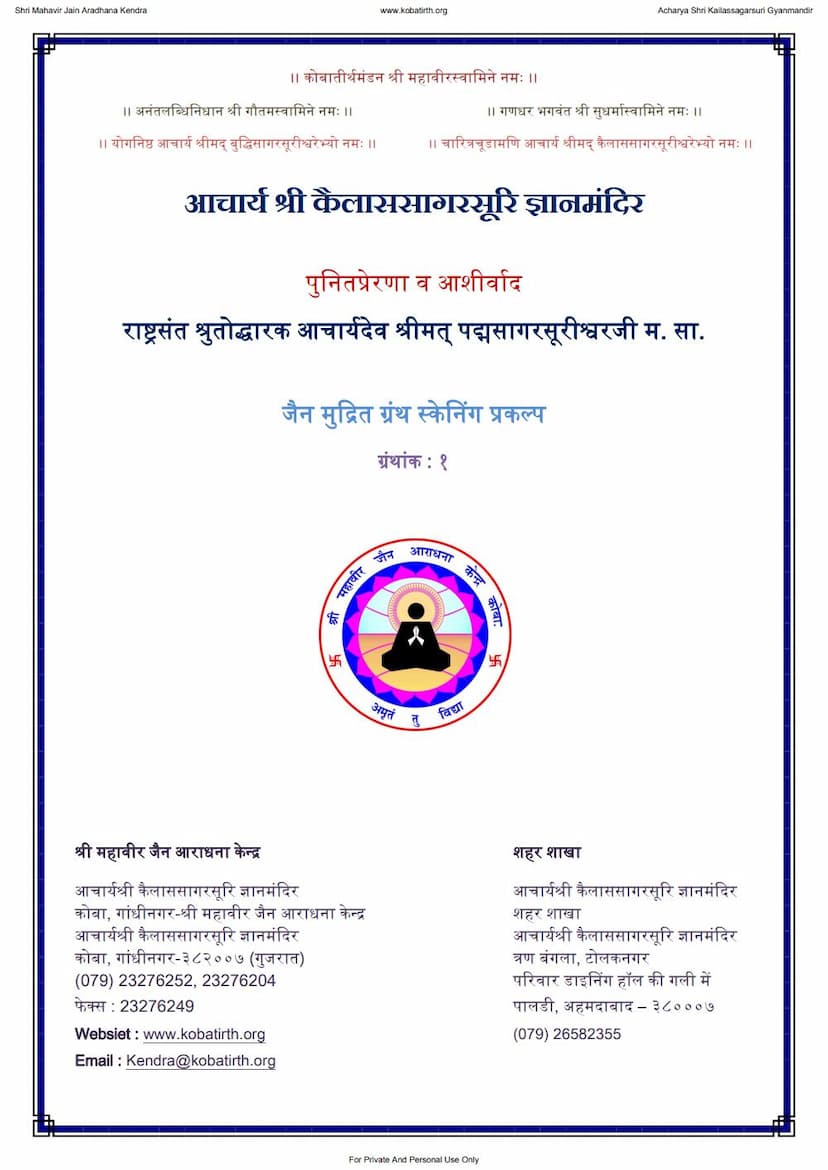Acharanga Sutram
Added to library: September 1, 2025

Summary
Here's a comprehensive summary of the provided text, which is primarily a digitized copy of the Acharanga Sutra:
Title: Acharanga Sutram (also referred to as Aayarang-Suttam) Author: Jain Sahitya Sanshodhak Samiti (published by) Publisher: Jain Sahitya Sanshodhak Samiti Publication Year: 1924 (Vikrama Samvat 1980, Mahavira Samvat 2450) Edition: Based on the German edition of Dr. Walter Schubring, Leipzig. This edition is in Devanagari script, with noted variations in readings and a glossary.
Overall Purpose and Content:
The Acharanga Sutra is a foundational text in Jainism, considered the first of the Angas (Agamas). It is primarily concerned with the principles of ascetic conduct, non-violence (ahimsa), and the path to liberation. This particular digitized version provides the original text in Prakrit (written in Devanagari), along with critical apparatus like different readings and a glossary, making it a scholarly edition.
Key Themes and Concepts:
The text, as presented in the digitized pages, delves into several core Jain principles:
- Ahimsa (Non-Violence): This is the paramount principle. The text repeatedly emphasizes the harm caused by violence to all forms of life, from the smallest organisms to larger beings. It discusses the impact of actions on oneself and others, particularly in relation to the elements (earth, water, fire, air, vegetation) and living beings.
- Karma: The Acharanga Sutra explains the concept of karma as the accumulation of actions and their consequences. It highlights that understanding karma (parijna) is crucial for spiritual progress. Ignorance of karma leads to further suffering and rebirth.
- The Soul (Atman): The text refers to the soul (aya, atma) and its journey through various existences. It questions the nature of the self, its past, present, and future.
- Asceticism and Renunciation: The teachings are directed towards ascetics (anagar) and outline the rigorous practices required for spiritual purification. This includes detachment from worldly possessions, desires, and sensory attachments.
- Knowledge and Understanding: The importance of right knowledge (jnana) and understanding (parijna) is stressed as the means to overcome ignorance and attachment, which are seen as the roots of suffering.
- Mindfulness and Self-Control: The text advocates for constant mindfulness (appamatto) and control over one's senses, thoughts, speech, and actions.
- The Cycle of Birth and Death (Samsara): The suffering inherent in the cycle of birth, death, and rebirth is a recurring theme, and liberation from this cycle is the ultimate goal.
- Ethical Conduct: The Acharanga Sutra provides guidance on various aspects of conduct, including not harming, not stealing, truthfulness, and celibacy. It addresses the temptations and challenges faced by ascetics.
- Living beings (Jiva): The text classifies living beings into different categories (e.g., mobile and immobile) and explains the repercussions of harming each.
- The World (Loka): The world is depicted as a place of suffering and illusion, from which the wise person seeks to detach themselves.
Structure and Organization (as seen in the digitized pages):
The digitized pages show segments of the Acharanga Sutra organized into chapters (Adhyayanas) and sections (Uddeshas). Based on the provided pages, it appears to cover:
- First Srutaskandha (First Division): This is the main part of the Acharanga Sutra.
- Adhyayanas (Chapters): The text is divided into Adhyayanas, with specific Uddeshas within them. For example, the provided pages show sections from Adhyayanas 1 through 9.
- Uddeshas (Sections/Topics): Each Uddesha seems to focus on particular aspects of conduct, types of beings, or specific spiritual concepts. For instance, there are discussions on:
- The harm caused by actions related to earth, water, fire, air, vegetation, and living beings.
- The impermanence of life and worldly attachments.
- The nature of desires and their consequences.
- The importance of equanimity and detachment in the face of hardship.
- The proper conduct for monks regarding food, clothing, and dwelling.
Specific Examples of Teachings (from the digitized content):
- Chapter 1 (1-1): Discusses the concept of the soul and its movement across directions, and the understanding of karma.
- Chapter 1 (1-2): Explains the harm caused by engaging with the earth element (prithvi-karma).
- Chapter 1 (1-3 to 1-7): Continues to detail the harm associated with various elements (water, fire, air, vegetation) and living beings (tasa-kaya, sthavara-kaya), emphasizing the need for understanding and non-violence.
- Chapter 2 (2-1 to 2-6): Focuses on worldly attachments, impermanence of life, the dangers of heedlessness, and the importance of self-reflection.
- Chapter 5 (5-1 to 5-6): Discusses the nature of possessions and the importance of detachment, the dangers of desire, and the path of non-violence.
- Chapter 8 (8-1 to 8-8): Details the rules and conduct for monks concerning begging for alms, accepting food, dealing with hardships like heat and cold, and renouncing all attachments.
- Chapter 9 (9-1 to 9-2): Highlights the importance of perseverance and detachment, even in the face of extreme conditions and temptations.
Significance of this Publication:
This publication from 1924, based on Dr. Schubring's German edition, is valuable as it makes a critical scholarly edition of the Acharanga Sutra accessible in Devanagari script. It includes textual variations and a glossary, aiding in a deeper understanding of this ancient and important Jain scripture. The dedication and acknowledgments indicate a dedicated effort to preserve and disseminate Jain literature.